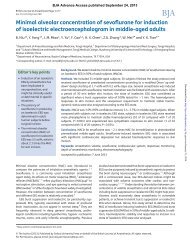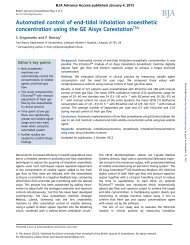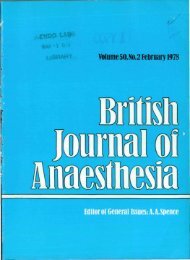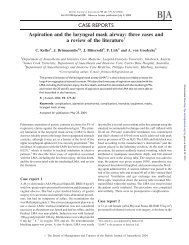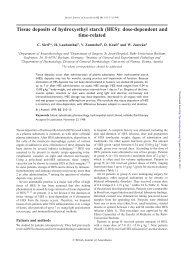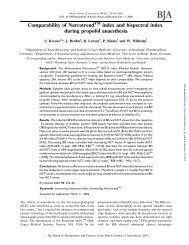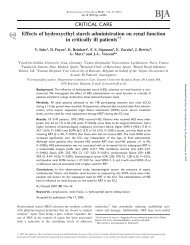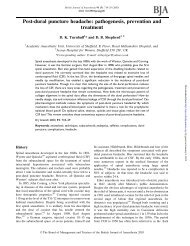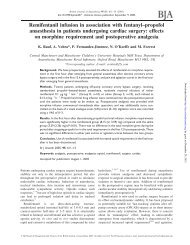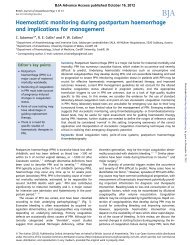Front Matter (PDF) - BJA
Front Matter (PDF) - BJA
Front Matter (PDF) - BJA
Create successful ePaper yourself
Turn your PDF publications into a flip-book with our unique Google optimized e-Paper software.
VOLUME 62 • NUMBER 6 • JUNE 1989<br />
Editor: GRAHAM SMITH
Athena<br />
Already installed in UK hospitals,<br />
Athena is proving its total flexibility in<br />
patient monitoring. Designed to keep<br />
pace with advances in technology,<br />
Athena is a fully modular system so<br />
that new parameter modules,<br />
program enhancements or more<br />
powerful components can easily-be<br />
integrated as necessary.<br />
Athena will collect, handle and<br />
present up to 16 physiological<br />
parameters on its high resolution 12"<br />
monitor, from ECG and respiration<br />
through to cardiac out-put, endital<br />
C02 and oxygen saturation.<br />
Central monitoring of up to 24<br />
connected bedside scopes, and bed<br />
to bed communication are also<br />
available throughout the system,<br />
providing simple to operate, flexible,<br />
yet very sophisticated patient<br />
monitoring.<br />
> Using "technology<br />
to Meet the Demands<br />
of the Future.<br />
fek M<br />
S&W Vickers Ltd, Ruxley Corner, Sidcup, Kent DA14 5BL*<br />
Telephone 01-309 0433 Telex 896328 Fax 01-309 0919
EDITORIAL BOARD<br />
Editor<br />
G. SMITH, Professor of Anaesthesia, University of Leicester Medical School, Leicester<br />
Editors of Educational Reviews<br />
A. P. ADAMS, Professor of Anaesthetics, United Medical and Dental Schools of<br />
Guy's and St Thomas's Hospitals, University of London<br />
C. J. HULL, Professor of Anaesthesia, University of Newcastle<br />
J. A. W. WILDSMITH, Consultant Anaesthetist, Royal Infirmary, Edinburgh<br />
G. DRUMMOND, Consultant Anaesthetist, Royal Infirmary, Edinburgh<br />
F. R. ELLIS, Reader in Anaesthesia, University of Leeds<br />
G. M. HALL (Secretary), Reader in Anaesthetics, University of London, Royal<br />
Postgraduate Medical School<br />
D. J. HATCH, Consultant in Anaesthesia and Respiratory Measurement, The<br />
Hospital for Sick Children .<br />
J. G. JONES, Professor of Anaesthesia, University oj Leeds<br />
W. W. MAPLESON, Professor of the Physics of Anaesthesia, University of Wales<br />
College of Medicine, Cardiff<br />
J. NORMAN (Treasurer), Professor of Anaesthetics, University of Southampton<br />
J. F. NUNN, Head of Division of Anaesthesia, Clinical Research Centre, Harrow;<br />
Honorary Consultant Anaesthetist, Northwick Park Hospital<br />
J. P. PAYNE, Emeritus Professor of Anaesthesia, University of London<br />
A. A. SPENCE (Chairman), Professor of Anaesthetics, Royal Infirmary, Edinburgh<br />
M. K. SYKES, Nuffield Professor of Anaesthetics, University of Oxford<br />
J. E. UTTING, Professor of Anaesthesia, University Department of Anaesthesia,<br />
Royal Liverpool Hospital<br />
Associate/Assistant Editors<br />
D. FELL, Senior Lecturer, University of Leicester<br />
C. D. HANNING, Senior Lecturer, University of Leicester<br />
D. J. ROWBOTHAM, Senior Lecturer, University of Leicester<br />
D. A. B. TURNER, Consultant Anaesthetist, Royal Infirmary, Leicester<br />
Technical Editor<br />
MRS S. E. LOWRY, PH.D., 19 Maiden Erleigh Drive, Reading, Berks<br />
British Journal of Anaesthesia ISSN 0007-0912 (monthly). Second Class postage paid, Rahway N. J.<br />
Postmaster: send address corrections to B.J.A. c/o Mercury International Ltd, Inc., 2323 Randolph<br />
Avenue, Avenel, N.J. 07001. (U.S.A. Subscription 8131.)
SIEMENS
Supporting life with consideration<br />
Sometimes the tender plant of life has to be kept blooming<br />
against heavy odds.<br />
Intensive Setvo<br />
The Servo Ventilator offers you a choice of sophisticated<br />
means of treatment. It gives you access to unique methods<br />
which have proven safe and sometimes decisive for<br />
both adults and prematures. Here we can name just a few:<br />
Pressure Controlled Ventilation<br />
with Inverse I:E ratio.<br />
Independent Lung Ventilation.<br />
Combined High Frequency Ventilation.<br />
Pressure Supported Ventilation.<br />
Get to know Servo Ventilator. It will give you possibilities<br />
beyond the ordinary in saving and caring for life.<br />
Siemens Limited, Medical Group. Siemens House<br />
Windmill Road. Sunburyon Thames.<br />
Middlesex TW16 7HS Telephone: (09327)85691.<br />
For countries outside Great Britain:<br />
SiemensElema AB. Life Support Systems Division.<br />
S-17195 Sdna. Sweden.<br />
Life Support Systems
iv BRITISH JOURNAL OF ANAESTHESIA<br />
PAIN 1989<br />
THE SECOND INTERNATIONAL SYMPOSIUM<br />
Herzliya, Israel September 16-19, 1989<br />
Sponsored by the Israel Pain Association.<br />
The programme will be devoted to advances in research and treatment of acute and<br />
chronic pain. Amongst the selected topics will be obstetric analgesia and<br />
postoperative pain.<br />
For information: Pain 1989 Secretariat,<br />
P.O.B. 50006,<br />
Tel Aviv 61500,<br />
Israel.<br />
Tel.: (03) 654571<br />
Telex: 341171 KENS IL<br />
Fax: 972 3 655674<br />
Electronic Mail: I.T.T.<br />
DIALCOM-05: GLU150
o E<br />
SaOitetrans minimizes<br />
the desatumtion risk<br />
from the OR to<br />
Recovery!<br />
Bridge your safety gap<br />
Undetected hypoxia<br />
during transport from the<br />
OR is now recognized to be<br />
a serious danger. Pulse oximetry<br />
is the idea] choice to<br />
bridge the safety gap from<br />
the OR to recovery.<br />
Diagnostic pulse wave<br />
Monitoring the plethysmographic<br />
pulse wave will<br />
alert you to circulatory<br />
depression, cardiac<br />
arrhythmia or other potentially<br />
life-threatening<br />
changes in circulation. And<br />
continuous pulse waveform<br />
display is now regarded as<br />
essential for validating SaO;<br />
readings.<br />
Clear display of vital<br />
data<br />
Separate, bright numeric<br />
displays ensure that the vital<br />
SaO2 and heart rate data can<br />
be seen from any viewing<br />
angle and under all lighting<br />
conditions.<br />
a D<br />
Monitoring without<br />
compromise<br />
Unlike other pulse oximeters,<br />
Satlitemmy does<br />
not compromise performance<br />
for portability.<br />
Datex now offers you<br />
the world's widest<br />
range of pulse oximetry<br />
solutions.<br />
In the U.K. please contact<br />
S&W Vickers, tel. 01 3090433,<br />
telex 896328 or fax 01309 0919<br />
DdTEX<br />
For people who care<br />
Datex/Instnimentarium Corp., P.O. Box 357, SF-00101 Helsinki Finland.Tel. + 358039411,Tx 126252 datex sf
BRITISH JOURNAL OF ANAESTHESIA<br />
EAST AFRICAN SOCIETY OF ANAESTHESIOLOGISTS<br />
ANNUAL SCIENTIFIC MEETING<br />
and<br />
REFRESHER COURSE<br />
Arusha, Tanzania September 7-9, 1989<br />
The Annual Scientific Meeting will be preceded by a Refresher Course sponsored<br />
jointly by the W.F.S.A., the University of Dar-es-Salaam and the Society.<br />
Further information from: Dr H. Luveno,<br />
P.O. Box 7097,<br />
Dar-es-Salaam.<br />
Dr E. Egan,<br />
P.O. Box 3010,<br />
Moshi,<br />
Tanzania.<br />
15th INTERNATIONAL CONGRESS<br />
ISRAEL SOCIETY OF ANESTHESIOLOGISTS<br />
Tel Aviv, Israel September 19-22, 1989<br />
First announcement and call for papers.<br />
Secretariat: Anesthesiologists 1989 Congress,<br />
P.O. Box 50006,<br />
Tel Aviv 61500,<br />
Israel.
ANAESTHESIA"*<br />
HAS COME A<br />
LONG WAY... J<br />
...SO HAS<br />
REVERSAL<br />
In recent years, many advances have been made in the<br />
field of anaesthesia, including reversal of residual<br />
neuromuscular blockade.<br />
A. H. Robins has been a major contributor to this area<br />
with Robinul.<br />
As an anticholinergic agent Robinul provides significant<br />
advantages over atropine: less initial tachycardia',<br />
better protection against the peripheral muscarinic<br />
effects of neostigmine 1 , and a better quality of recovery 2 .<br />
At reversal, when administered simultaneously with<br />
neostigmine, Robinul is associated with greater<br />
cardiostability than separate injections 3 .<br />
ROBINUL- NEOSTIGMINE injection contains standard<br />
doses of Robinul and neostigmine in a 1ml ampoule,<br />
provides dependable and convenient reversal of<br />
residual neuromuscular blockade, and contributes<br />
further towards improvements in anaesthesia.<br />
I<br />
GLYCOPYRROLATE<br />
NEOSTIGMINE<br />
NKOSTK.MINK MKTHYLSl LPHATK<br />
Each lml contains Gtycopyrroltte USP 500 micrograms (OSmg) Neostigmine Methyfsulphate BP 2500 micrograms I2.5mg! Mication: Reversa<br />
3t residual non-d«potarittng(comp«1itive) neuromuscular block Oau$»m4AJmmittTWt\on: Intravenous injection Adults and Older Patients 1 2ml 12500 microgfams neostigmine methylsulphaWSOO<br />
rncrogrtfttf gtycopyrroiale to 5000 nucrograms neosugmme iMthylsulphate/1000 micrograms glycapyrrolaiel over a penod of 10-30 seconds Alternatively 0 02rnl/kg 150 microgram<br />
- * • • - - - rrogrems gtycopyrrolate per kg body weight) over a psnod of 10 30 seconds Children 002ml/kg (50 micrograms neostigmine methylsulphate/10 micro<br />
pam gfycopyrrobM ptr kg tMdy wwgfati owtr a period of 10-30 seconds These doses may be repealed if adequate reversal is not achieved Total doses m excess of 2ml are nc<br />
recouwModed. CMtot-MfeaiMr HytmteuithniY to ingredients. Mechanical obstruction of gastrointestinal or urinary tracts Concomitant administration of suKamethomum Sid* ffftcts<br />
Meostigmine induced (muscarinic) side effects - bradycardia, increased oropharyngeat secretions, cardiac dysrhythmias. bronchospasm. increased gasuointesuna< activiiy etc<br />
Glycopyrrolate induced side effects dry mouth, difficult-/ m micturition, cardiac dysrhythmias. disturbances of visual accommodation, inhibition of sweating Prtcjti—t: Use with caution n<br />
aatients with bronchospasm. severe bradycardia. fever, glaucoma, coronary artery disease, congestive heart failure, cardiac dysrhyitimias. hypertension, thyrotowcosis, epilepsy or Paritm<br />
wmsm Use with caution m patients wtth mtestmaf anastomoses. Safety m pregnancyJlactatton has not been established B**tc NHS price CIO 37110 * lml ampoules! Ufal Cm»§»Pf P0^<br />
Padtaft Q»aaMt*s Packs of 10 ampoules fwrtk$t WansatiMi Robtnol Neostigmine Infection can be used when atropine has been used as a pre-operatrve arm-cholmergic Prefac<br />
01OOVOO99 Pi—'m Alfcoriirtoii Wimfcii 86^77/1 fMtnaces 1 Mirakhur RK et al Anaesth Analg 19 81. 60. 557-562 2 Sheref SE Br J Anaesth 1985. 57 IBS 191 3 Mostafa SM<br />
itocevic M Anaesthesia 1984; 39 1207 1213 full Data Sheet available on request from A H.Robins Company Ltd.Sussex Manor Business Park. Gatwick Road, Crawley, West Sussex RH10 ?NH
GUIDE TO CONTRIBUTORS<br />
The purpose of the British Journal of Anaesthesia<br />
is the publication of original work in all branches<br />
of anaesthesia, including the application of basic<br />
sciences. One issue each year deals mainly with<br />
material of postgraduate educational value.<br />
PAPERS<br />
Papers submitted must not have been published<br />
in whole or in part in any other journal, and are<br />
subject to editorial revision. It is a condition of<br />
acceptance for publication that copyright becomes<br />
vested in the journal and permission to republish<br />
must be obtained from the Editor.<br />
Papers based on clinical investigation should<br />
conform to ethical standards as set out in the<br />
Declaration of Helsinki. In the case of animal<br />
studies it is the responsibility of the author to<br />
satisfy the Board that no unnecessary suffering<br />
has been inflicted.<br />
LEGAL CONSIDERATIONS<br />
Authors should avoid the use of names, initials<br />
and hospital numbers which might lead to<br />
recognition of a patient. A patient must not be<br />
recognizable in photographs unless written consent<br />
of the subject has been obtained. A table or<br />
illustration that has been published elsewhere<br />
should be accompanied by a statement that<br />
permission for reproduction has been obtained<br />
from the author and publishers.<br />
PREPARATION OF MANUSCRIPT<br />
Three copies of each manuscript should be<br />
submitted and should indicate the title of the<br />
paper, the name(s), qualifications and full address(es)<br />
of the author(s), and be in letter quality<br />
heavy type (not dot matrix), double-spaced on one<br />
side only of the paper, with a wide margin.<br />
Contributors should retain a copy in order to<br />
check proofs and in case of loss.<br />
Manuscripts should be accompanied by a<br />
formal letter of request for publication which<br />
should be signed by all of the authors.<br />
Papers in recent issues of the British Journal of<br />
vni<br />
Anaesthesia should be consulted for general and<br />
detailed presentation. They are most often subdivided<br />
into:<br />
Title page<br />
Summary<br />
Introduction (not headed)<br />
Methods<br />
Results<br />
Discussion<br />
Acknowledgements<br />
List of references<br />
Tables<br />
Illustrations<br />
Title page<br />
There should be a separate title page, including<br />
the name(s), degrees and address(es) of author(s).<br />
It should be made clear which address relates to<br />
which author. Authors' present addresses differing<br />
from those at which the work was carried out,<br />
or special instructions concerning the address for<br />
correspondence, should be given as a footnote on<br />
the title page and referenced at the appropriate<br />
place in the author list by superscript symbols. If<br />
the address to which proofs should be sent is not<br />
that of the first-mentioned author, clear instructions<br />
should be given in a covering note and<br />
not on the title page. The title page should be<br />
paginated as page 1 of the paper.<br />
A short running title containing not more than<br />
50 characters and spaces, and three to five key<br />
words or phrases (for indexing) should be included.<br />
Summary<br />
The summary will be printed at the beginning<br />
of the paper. It should be on a separate sheet, in<br />
the form of a single paragraph which gives a<br />
succinct account of the problem, the methods,<br />
results and conclusions, and normally should be<br />
of 50-150 words. It may be used as it stands by<br />
abstracting journals.<br />
Introduction<br />
The introduction should give a concise account<br />
of the background of the problem and the object
A 20661 E<br />
Anaesthesist<br />
Organ der<br />
Mit Sonderteil OsterreichischenGesellschaftfurAnaesthesiologie, Reanimation und Intensivtherapie<br />
Tt • 1 A -jL • DeutschenGesellschaftfurAnaesthesiologieundlntensivmedizin<br />
M\£gjOnM—AjUieStneSie Schweizerischen Gesellschaft fur Anaesthesiologie und Reanimation<br />
(erscheint zweimonatlich) (Societe Suisse d'Anesthesiologie et de Reanimation)<br />
J. Jage<br />
L. Brandt, F. Mertzlufft, W. Dick<br />
F. Konrad, A. Deller, J. Diatzko,<br />
J.E.Schmitz,J.Kilian<br />
H. Suttmann, G. Juhl, B. Baur,<br />
W. Morgenstern, A. Doenicke<br />
E. Pfenninger, K.H. Lindner,<br />
F.W.Ahnefeld<br />
Th.A. Crazier, M. Sydow. J. Muller,<br />
M. Langenbeck, J. Radke,<br />
D. Kettler<br />
H. Mang, J. Weindler, Ch.L. Zapf<br />
H. Lammer, G. Mitterschiffthaler,<br />
F. Fischer<br />
K. Falk, H. GroB, K. Zinganell<br />
G. Mitterschiffthaler, J.M. Hackl,<br />
R. Neumann<br />
Ch. Putensen, M. Baum, W. Koller,<br />
G.Putz<br />
0. Mayrhofer<br />
38. Band Heft 4 April 1989<br />
Qbersichten<br />
Methadon - Pharmakokinetik und Pharmakodynamik eines Opiates<br />
[Methadone: pharmacokinetic and pharmacodynamic features of an opiate] 159<br />
Originalien<br />
Verhalten des arteriellen und gemischtvenosen Blutgasstatus in der Initialphase der<br />
Intubationsapnoe<br />
[Arterial and mixed-venous blood gases during early intubation apnea] 167<br />
paO2-Abfa!l nach intratrachealer Applikation von Lokalanaesthetika und 0,9%iger Natriumchloridlosung<br />
[Flexible bronchoscopy of ventilator patients in local anesthesia. Decline in paO2 due to local<br />
anesthesiaand NaCIO.9%] 174<br />
Visuelle EEG-Analyse zurSteuerung intravenoser Narkosen mit Propofol<br />
[Visual analysis of EEG for regulation of intravenous anesthesia with propofol] 180<br />
Die Infusion von THAM (Trishydroxymethylaminomethan) alsTherapie zur Senkung des erhohten<br />
intrakraniellen Druckes beim akuten Schadel-Hirn-Trauma<br />
[Use of THAM (tris-hydroxymethylaminomethan) for rapid control of high intracranial pressure in<br />
severe head injury] 189<br />
Hamodynamische Effekte des Benzodiazepin-Antagonisten Flumazenil nach Laparotomien unter<br />
einertotalenintravenosenAnaesthesiemitMidazolam<br />
[Hemodynamic effects of the benzodiazepine antagonist flumazenil after laparotomies in total<br />
intravenous anesthesia] 193<br />
Intensivmedizin<br />
Postoperative Atemtherapie mit Incentive Spirometry<br />
[Incentive spirometry in postoperative respiratory care] 200<br />
Fehlerund Gefahren<br />
Zungengrundstruma, etn unerwartetes und seltenes Intubationshindernis<br />
[Lingual thyroid, an unexpected and rare obstacle to intubation] 206<br />
Fallberichte<br />
Erschwerte Intubation und Narkose bei Morbus Pfaundler Hurler<br />
[Difficulties encountered in intubation and anesthesia of a patient with Pfaundler-Hurfer disease] 208<br />
Malignes Neurolept Syndrom und maligne Hyperthermie<br />
[Neuroleptic malignant syndrome, a risk factor in malignant hyperthermia] 210<br />
Technische Neuerungen<br />
PEEP-Welle: Ein automatisiertes Verfahren zur bettseitigen Bestimmung der Volumen/<br />
Druck-Beziehung der Lunge beatmeter Patienten<br />
[An automated technique for determination of the volume/pressure ratio in the lungs of<br />
mechanically ventilated patients at the bedside] 214<br />
Laudatio<br />
Professor Herbert Benzer zum 60. Geburtstag<br />
Buchbesprechungen<br />
Fachnachrichten<br />
KongreBkalender<br />
Indexed in Current Contents<br />
Zum Deutschen AnaesthesiekongreB in Bremen<br />
Annual subscription price DM 380.20 (including carriage charges)<br />
Springer-Verlag<br />
101 AnaesthestSt ISSN 0003-2417 ANATAE (1989) 38(4) 159-224<br />
Gedrutid auf sdurefretem Paper<br />
220<br />
213,222<br />
222<br />
223
of the investigation. Previous work should be<br />
quoted only if it has a direct bearing on the<br />
present problem.<br />
Methods<br />
Methods must be described in sufficient detail<br />
to allow the investigation to be interpreted and<br />
repeated by the reader. Any modification of<br />
previously published methods should be described<br />
and the reference given. If the methods<br />
are commonly used, only a reference to the<br />
original source is required.<br />
Drugs<br />
When a drug is first mentioned it should be<br />
given the generic or official name, followed in<br />
parentheses by the chemical formula only if the<br />
structure is not well known, and by the capitalized<br />
proprietary name.<br />
Results<br />
Description of results, while concise, should<br />
permit repetition of the investigation by others.<br />
Data should not be repeated unnecessarily in text,<br />
tables and figures, and unwarranted numbers of<br />
digits should be avoided. Significance should be<br />
given as values of probability. The desired<br />
positions of tables and figures may be indicated by<br />
written instructions enclosed within lines and<br />
brackets, for example:<br />
(TABLE III near here)<br />
Discussion<br />
The discussion should not merely recapitulate<br />
the results, but should present their interpretation<br />
against the background of existing knowledge. It<br />
should include a statement of any assumptions on<br />
which conclusions are based.<br />
Acknowledgements<br />
Acknowledgements will be printed in small<br />
type. They should be brief, and should include<br />
reference to sources of support and sources of<br />
drugs not freely available commercially.<br />
References<br />
There should be a table of references at the<br />
conclusion of the paper, commencing on a new<br />
sheet.<br />
References must be numbered consecutively in<br />
the order in which they are first mentioned in the<br />
BRITISH JOURNAL OF ANAESTHESIA<br />
text, with the exception of review articles, when<br />
references should be arranged alphabetically.<br />
References in text, tables and legends should be<br />
identified by arabic numbers appearing in the text<br />
in square brackets.<br />
Use the style of references adopted by the U.S.<br />
National Library of Medicine and used in Index<br />
Medicus. The titles of journals must be given in<br />
full.<br />
The names and initials of all authors should be<br />
listed.<br />
Text references to "unpublished observations "<br />
or "personal communications" should not be<br />
included in the final list of references. Authors are<br />
responsible for verifying that the wording of<br />
references to unpublished work is approved by<br />
the persons concerned. Papers which have been<br />
submitted and accepted for publication should be<br />
included in the list, the phrase "in press"<br />
replacing volume and page number. Information<br />
from manuscripts submitted but not yet accepted<br />
should be cited in the text as unpublished<br />
observations.<br />
Examples of correct forms of references:<br />
Journals (list all authors) ;<br />
Brown B R jr, Gandolphi A J. Adverse effeas of volatile<br />
anaesthetics. British Journal of Anaesthesia 1987; 59: 14-23.<br />
Chapter in a Book:<br />
Hull C J. Opioid infusions for the management of postoperative<br />
pain. In: Smith G, Covino B G, eds. Acute Pain.<br />
London: Butterworths, 1985: 155-179.<br />
Monographs:<br />
Moore, D C. Regional Block, 4th edn. Springfield, Illinois:<br />
Charles C Thomas, 1979.<br />
Restrict references to those that have direct<br />
bearing on the work described and cite only<br />
references to books and articles published in<br />
Index Medicus journals.<br />
It is essential that authors verify the content<br />
and detail of references which they list against the<br />
original articles, as this responsibility cannot be<br />
accepted by either Editors or publishers.<br />
Tables<br />
All tables should be on separate sheets and be<br />
capable, with their captions, of interpretation<br />
without reference to the text. They should be<br />
numbered consecutively with roman numerals.<br />
Units in which results are expressed should be<br />
given in brackets at the top of each column, and<br />
not repeated on each line of the table. Ditto signs<br />
are not used. Footnotes are not used.
There is a simple solution to<br />
choosing a relaxant for all<br />
operative<br />
procedures<br />
NORCURON<br />
vecuronium bromide<br />
Six years experience with Norcuron and many anaesthetists are only<br />
beginning to appreciate the significance of this compound in terms of<br />
flexibility in use, predictability of action, wide therapeutic safety margin<br />
and minimal side effects.<br />
mromtATtom i p*»e **> *> Da* sheet tor tun<br />
Ono wcurpnium bromKM irt • butteredfreeze dnedtom,wfji* 5nUampouleo«aaonlor(hei1eaofiC*i«foe'do«a« mum Qo%a 'anqnghom 150-250rracrognra/fcflrwy beaQffMrialwill in9<br />
'rfaJJQft wai tte y>c^aawQnt hy tn u>e pt Worcufpff. In OTIW mm a*<br />
Earn* eauboo i»wuKf ta t«»«i*«). and ««v •*"•" d<br />
o t* tw eonoo«aw UN of «na«t<br />
tt tw Mai do** ana •oww p«a«* way *«« i«qv« • rugtwi deaa<br />
ahewid * powtoW fta aontOM Dafaw aduwiitaaoii ot Wororot NcMciiNwicar0ag<br />
Tr«tponaM)aoM*ava*SBlolVwnaufemu«cularblcKt(ad«c«u»«dbrNc»Cwron«<br />
: ProductLicanc*No 3524/0013<br />
^^_^_ Further information is available upon request.<br />
FWWr* • * »w Aaeaaa of tew<br />
m «I matancas Hotaaon<br />
te NHS Coalt. CfiS M pff te» of 70 • lOmg M<br />
Organon Teknika Ltd Science Park. Milton Road, Cambridge CB4 4FL<br />
NORCURON<br />
See for yourself
Xll BRITISH JOURNAL OF ANAESTHESIA<br />
Illustrations<br />
Photographs should be unmounted glossy<br />
prints, and should be protected adequately for<br />
mailing. Surfaces should not be marred with<br />
clips, pins or by heavy writing on the back.<br />
Drawings, charts and graphs should be in black<br />
india ink on white paper and, if in sets, should be<br />
presented at a uniform magnification. Illustrations<br />
should be clearly numbered on the back, preferably<br />
in soft pencil, with reference to the text,<br />
and using arabic numerals. They should be<br />
accompanied on a separate sheet by a suitable<br />
legend. Lettering should be professional-looking,<br />
uniform, preferably in a common typeface, large<br />
enough to read at a reduced size, and in proportion<br />
to the illustrated material. Lines in the original<br />
must also be thick enough to allow for reduction.<br />
Magnifications, especially in photomicrographs,<br />
should be indicated by a scale on the photograph<br />
itself, in order to remain appropriate after<br />
reduction. Symbols which are to appear in the<br />
legend should be chosen from the following<br />
available types:<br />
• O a • v • A • o<br />
The name of the author and title of the paper<br />
should also be written in soft pencil on the back of<br />
the illustrations.<br />
It is emphasized that care taken in the original<br />
preparation of figures will obviate the time-consuming<br />
and expensive necessity of their revision.<br />
General information<br />
Instructions to the printer. Words to be printed<br />
in lower-case italics should be indicated by one<br />
underline. Two underlines indicate small capitals,<br />
three indicate large capitals and four, italic<br />
capitals. A wavy underline indicates a word to be<br />
printed in bold type.<br />
Headings in the text. Six possible grades are<br />
available, and may be indicated by the following<br />
letters of identification:<br />
A PART I (capitals)<br />
B RESULTS (small capitals)<br />
C Blood-Gas Analysis (I.e. roman)<br />
D The Action of Drugs (italics, centre)<br />
E Lung function studies (italics, full out)<br />
F Volume. Large volumes... (italics, indent)<br />
Symbols and Abbreviations. In accordance with<br />
Editorial adoption of SI Units, abbreviations and<br />
symbols should follow the conventions described<br />
in the booklet Units, Symbols and Abbreviations. A<br />
Guide for Biological and Medical Editors and<br />
Authors (ed. G. Ellis), published by and available<br />
from The Royal Society of Medicine, 1 Wimpole<br />
Street, London, W1M 8AE. Words for which<br />
abbreviations are not included should be written<br />
in full at first mention in the summary and again<br />
in the text and followed by the abbreviation in<br />
brackets. This will usually be in the form of large<br />
capitals without separating points.<br />
Spelling, etc. British spelling should be used<br />
with "z" rather than "s" spelling in, e.g.<br />
organize, organization.<br />
SHORT, RAPID COMMUNICATIONS<br />
Authors are encouraged to submit short manuscripts<br />
suitable for rapid publication. In general,<br />
these should conform to the requirements outlined<br />
above, but with the following differences:<br />
Format. Summary; Introduction (not headed);<br />
Methods and Results; Comment.<br />
Size. Not more than: 6 references, 1 table or<br />
1 figure, one-and-a-half pages of printed text<br />
(1200 words).<br />
CORRESPONDENCE<br />
It is proposed that a proportion of the Journal be<br />
devoted to correspondence each month. Every<br />
effort will be made to ensure that correspondence<br />
arising from papers in a recent issue is published<br />
without delay, and for this reason, relevant<br />
correspondence will be given priority over that<br />
pertaining to original research. Authors of correspondence<br />
concerning original work will receive<br />
proofs at the Editor's discretion.<br />
PROOFS<br />
These should be corrected and returned to the<br />
technical editor within 48 hours of receipt. Overseas<br />
contributors should return their proofs by airmail.<br />
REPRINTS<br />
Twenty-five reprints of articles will be dispatched<br />
to the authors after publication. Further reprints<br />
can be supplied if application is made on the order<br />
form attached to the proofs. The order form<br />
should be returned with the proofs.
ANNUAL MEETING<br />
CANADIAN ANAESTHETISTS' SOCIETY<br />
j Joint Meeting with the<br />
I Association of Anaesthetists<br />
of Great Britain and Ireland.<br />
OTTAWA, June 9 to June 13, 1989.<br />
Penlon<br />
SEE YOU ON OUR STAND
XIV BRITISH JOURNAL OF ANAESTHESIA<br />
THE NORTH BRITISH PAIN ASSOCIATION<br />
1989 ST ANDREWS PAIN SYMPOSIUM<br />
NEUROSURGERY FOR CHRONIC PAIN-<br />
CURRENT TECHNIQUES AND FUTURE OPTIONS<br />
University of St Andrews June 14-16, 1989<br />
Speakers: Professor M. Bond (Glasgow)<br />
Professor E. Hitchcock (Birmingham)<br />
Mr I. Jacobson (Dundee)<br />
Dr H. J. McQuay (Oxford)<br />
Mr J. B. Miles (Liverpool)<br />
Dr B. Nashold (U.S.A.)<br />
Dr B. Sjolund (Sweden)<br />
Professor R. Tasker (Canada)<br />
Mr T. R. K. Varma (Dundee)<br />
Professor P. J. Wall (London)<br />
Further details from: Dr W. A. Macrae,<br />
Consultant Anaesthetist, Pain Clinic,<br />
Royal Infirmary,<br />
Dundee, DD1 9ND.
Until now, all CO2<br />
monitors have had<br />
some limitation...<br />
Some monitors are sensitive<br />
to moisture, others have no<br />
auto-compensation for N2O,<br />
many have no CO2 waveform<br />
or trend display, and none<br />
offer true transport capability.<br />
No longer...<br />
Now there is Normocar/<br />
200, the compact CO2<br />
monitor for the future. With<br />
no limitations.<br />
Normocap R 200<br />
solves the moisture<br />
problem<br />
To ensure tliat moisture,<br />
secretions or particles never<br />
reach the gas sensor, we<br />
developed a revolutionary,<br />
new water separation system,<br />
D-fend.<br />
D-fend offers you the<br />
ultimate moisture protection:<br />
a proprietary hydrophobic<br />
filter for guaranteed<br />
water separation.<br />
Options:<br />
Integrated, paramagnetic O2<br />
Battery for transport monitoring<br />
D-fend has been<br />
designed for long-term use,<br />
but is fully disposable whenever<br />
stringent infection<br />
control is required.<br />
In the U.K. please contart<br />
S& W Vickers, tel. 01309 0433,<br />
telex 896328 or fax 01309 0919<br />
DdTEX<br />
For people who care<br />
Datex/Instrumentarium Corp., P.O. Box 357, SF-00101 Helsinki Finland, Tel. + 3580394 n, Tx 126252 datex sf
xvi BRITISH JOURNAL OF ANAESTHESIA<br />
BIOLOGICAL ENGINEERING SOCIETY<br />
DEVELOPMENTS IN INTENSIVE CARE MONITORING<br />
London June 15, 1989<br />
To be held at the Morris Lecture Theatre, St Bartholomew's Hospital, London.<br />
Secretariat: Mr D.T. Delpy,<br />
Department of Medical Physics and Bio-Engineering,<br />
University College London,<br />
1st Floor, Shropshire House,<br />
11-20 Capper Street,<br />
London WC1E 6JA.
he 9000 Syringe Pump from Ohmeda.<br />
Designed to complement today's<br />
anaesthesia workstation.<br />
Infusion anaesthesia. It's the ideal<br />
addition BJOTJ fj<br />
sa. Take your youi best shot.<br />
sia delivery capability.<br />
To take advantage of all that IV anaesthesia<br />
techniques offer, an infusion pump adapted<br />
from critical care isn't enough.<br />
You need the 9000 Syringe Pump. The one<br />
for anaesthesia.<br />
The 9000 is designed and built by Ohmeda, the<br />
leader in anaesthesia systems, to meet your<br />
needs for more flexible, more controllable IV<br />
delivery at your workstation.<br />
The 9000 was also developed in cooperation<br />
with major pharmaceutical manufacturers to<br />
complement the full range of shorter-acting,<br />
more controllable anaesthesia drugs—hypnotics,<br />
muscle relaxants, analgesics, hypotensives<br />
and inotropes.<br />
A smoother course in each case.<br />
With the 9000 Syringe Pump, the full dose can<br />
be delivered, including loading and maintenance<br />
doses, and intraoperative boll No need<br />
for special set ups, added costs.<br />
During loading, the 9000 administers the<br />
drug dose smoothly and evenly which can<br />
lessen the haemodynamic depressant effects of<br />
some drugs.<br />
During maintenance, 0.1 mL/hr to 200 mL/hr<br />
output offers a flexible infusion range to manage<br />
the wide choice of regimes encountered in<br />
anaesthesia. A choice of standard syringes<br />
helps match size to dose to cut drug waste.<br />
Anytime, selectable bolus delivery helps you<br />
quickly react to changing anaesthesia requirements<br />
such as increasing anaesthetic depth or<br />
muscle relaxation. No need for a second syringe.<br />
No need to remove a syringe from the pump.<br />
The Ohmeda 9000.<br />
Not merely an infusion<br />
pump-today's<br />
, advanced infusion<br />
In the continuous infusion laesthesia system<br />
mode, the display indicates for the operating<br />
syringe size, volume infused theatre.<br />
Contact your Ohmeda<br />
representative or call<br />
0279 442001 to make<br />
a 9000 Syringe Pump<br />
part of your system.<br />
If • bolus is selected, the<br />
display indicates the rate<br />
and the volume delivered in<br />
that bolus. When complete,<br />
the readout reverts to the<br />
continuous infusion display.<br />
Ohmeda<br />
Ohmeda<br />
Elizabeth Way<br />
Ha rlow<br />
Essex CM 19 SAB<br />
0279 29692<br />
UK Sales 0279 442001<br />
Telex 81497<br />
BOC Haaitb Care » 1988 The BOC Group
ANAESTHESIA and<br />
INTENSIVE CARE<br />
Journal of the Australian Society of Anaesthetists<br />
Editor: J. G. Roberts; Associate Editor: Jeanette Thirlwell; Assistant Editor: A. W. Duncan;<br />
Editorial Committee: A. B. Baker, T. C. K. Brown, N. M. Cass, J. N. Ditton, D. B. Gibb, A. H.<br />
llsley, J. H. Overton, T. E. Oh, J. D. Paull, P. F. Reilly, W. R. Thompson.<br />
Anaesthesia and Intensive Care is a quarterly journal presenting articles of scientific and clinical interest in<br />
the specialities of Anaesthesia, Intensive Care Medicine and related disciplines. Frequent symposium<br />
issues, comprehensive review articles, dissertations on the history of anaesthesia and education and<br />
training in the specialities are very informative, while our correspondence section gives contributors an<br />
opportunity to express points of view. Future meetings, both Australian and International, are listed.<br />
The Journal is international in content and readership and offers very reasonable subscription rates with<br />
American Express and Visa facilities.<br />
SUBSCRIPTION FORM<br />
commencing with the current volume.<br />
NAME<br />
ADDRESS<br />
I wish to subscribe to ANAESTHESIA AND INTENSIVE CARE<br />
(BLOCK LETTERS PLEASE)<br />
COUNTRY DATE<br />
POSTCODE.<br />
• (•) PLEASE SEND BY SURFACE MAIL • (•) PLEASE SEND ME INFORMATION ON AIR MAIL RATES FOR MY<br />
REGION<br />
D(/) MY PAYMENT IS ENCLOSED •(•) PLEASE INVOICE ME WITH THE FIRST ISSUE<br />
FOR PAYMENT BY CREDIT CARD<br />
Please charge my<br />
CH Visa CH American Express<br />
Cardholder's Name<br />
Credit Card No Expiry Date<br />
Signature<br />
Annual Subscription Rates (1989 rates):<br />
• Within Australia — surface mail : Aust $48.00 back issues: $12.00<br />
— air mail : Aust $60.00 back issues: $15.00<br />
• Outside Australia—surface mail : Aust $68.00 back issues: $17.00<br />
— air mail : Rates available on request
teamwork<br />
You strive for It In the Operating Theatre.<br />
We strive for It In our products.<br />
Narkomed 2B and Vltalerf* 1000,<br />
alone, powerful performers;<br />
together... the solution.<br />
Configure your Vltalerf* 1000 for pulse oxlmetry,<br />
capnography and non-Invasive blood pressure<br />
measurements. Upgrade your gas delivery system<br />
with the Narkomed 2B and the extensive list of<br />
standard components. Our products are designed<br />
to enhance or create a Centralized Anesthesia<br />
Network of today with tomorrow's standards.<br />
The Narkomed 2B and the Vltalert" 1000—Truly<br />
Integral Teamwork.<br />
Drager<br />
Draeger Limited<br />
The Willows<br />
Mark Road<br />
Hemel Hempstead<br />
Hertfordshire HP2 7BW<br />
Telephone: 04423542<br />
Fax: 044240327<br />
Telex: 826093<br />
A unique combination-<br />
North American Drager of the USA and<br />
Draeger Medical of the UK. Your new team of<br />
excellence in anesthesia sales and service.<br />
1<br />
NORTH<br />
AMERICAN<br />
DRAGER<br />
148B Quarry Road<br />
Telford, Pennsylvania 18969 USA<br />
Telephone (215) 723-9824<br />
TWX 510-661-6148<br />
NOAMDRAGER TEL<br />
Facsimile (215) 721-9561
British Journal of Obstetrics<br />
and Gynaecology<br />
Published on behalf of the Royal College of Obstetricians and Gynaecologists<br />
Editor<br />
D.B. Paintin London<br />
The British Journal of Obstetrics and Gynaecology<br />
has been published since 1902 when it began as the<br />
Journal of Obstetrics and Gynaecology of the<br />
British Empire. Regarded as the premier organ of<br />
the specialty in Britain, it publishes papers from<br />
throughout Europe and from an increasingly wide<br />
circle of international contributors. The Journal is<br />
aimed at both the practising clinician and the<br />
clinical scientist and the core content consists of<br />
reports of original work in obstetrics and<br />
gynaecology and related subjects such as human<br />
reproductive physiology and contraception.<br />
Subscription Information<br />
British Journal of Obstetrics and Gynaecology is published monthly. Subscription rates for<br />
1989 are £62.00 (UK), £74.50 (overseas), $129.00 (USA & Canada) post free. Members and<br />
Fellows of the Royal College of Obstetricians and Gynaecologists are entitled to subscribe at<br />
the special price of £52.00/$88.50.<br />
Order Form<br />
Please tick the appropriate box and return to BlackweU Scientific Publications Ltd, P.O. Box 88, Oxford. England.<br />
fj] I would like to subscribe to British Journal of Obstetrics and Gynaecology<br />
• I wish to pay by cheque/money order tdrima» m-mwyj and enclose the sum of<br />
• I wish to pay by Access/Barclaycard/VISA/Mastercard {Metros im-man-i<br />
Please debit my credit card no.<br />
Expiry date with' the sum of<br />
Signature Dale<br />
• Please send me a free specimen copy of British Journal of Obstetrics and Gynaecology<br />
Name<br />
Address<br />
BlackweU Scientific Publications<br />
P.O. Box88, Oxford, England
VEOLAR<br />
Intensive Care Ventilation...<br />
Comprehensive, Versatile, Dependable.<br />
The VEOLAR Adult/Pediatric Ventilator and LEONARDO, Advanced Ventilation Monitoring Software<br />
Comprehensive: All the features<br />
you expect from a complete<br />
ventilation system... all the modes,<br />
accurate monitoring and helpful<br />
alarms.<br />
Now Pressure Control Ventilation<br />
with spontaneous breathing. And<br />
LEONARDO, the Advanced Patient<br />
Data Manager.<br />
Versatile: Exceptional performance<br />
from controlled ventilation to<br />
spontaneous breathing.<br />
Now with an expanded minute<br />
volume range from 0.2 to 50 liters<br />
per minute for all adult and<br />
pediatric applications.<br />
Dependable: Manufactured with<br />
Swiss quality design and workmanship<br />
to be extremely reliable<br />
and easy to service.<br />
Now with a proven record of<br />
world wide user satisfaction.<br />
HAMILTON<br />
MEDICAL<br />
I/;../,., •••••. :;y SERVE MANKIND<br />
Manufacturer. Hamilton Medical AG. Via Nova CH-7403 Rhazuns/Switzerland. Telephone 081 37 26 27; Telex 851321 hmed ch, Fax 081 37 2689<br />
USA: Hamilton Medical Inc.. P.O. 8ox 30008. Reno. NV 89520, Telephone (702) 786-7599. (800) HAM-MED-1, Fax (702) 323-7259<br />
Great Britain: Hamilton (G.B.) Limited, Parkgate House, Broomhill Road. London SW184JQ, Telephone 01-871 5124, Telex 917003 LPCG<br />
Germany: Hamilton Deutschland GmbH, Daimlerweg 5A. Postfach 110565, D 6100 Darmstadt, Tel. (06151) 8 50 85. Telex 419684. Fax (06151) 8917 33<br />
For all other countries contact Switzerland or our local dealer<br />
Specifications are subject to alteration without prior notice. Leve*
day in day out<br />
nans<br />
ABBOTT<br />
Easy control, rapid recovery<br />
Prescribing Information: isoRufane Indications: tor inhalation anaesthesia Dose ould begin al 0.5% and be adjusted appropnalely. AUtaBUbomorinUd<br />
••• • • - -- - i ">•"•- ^-- *= ^'-'- c— .-'...•-. >- .,-, u o_^ ,*5% ic^.ti.Lf^-.^ i- s rrn^i^A -,i (-;.vo*n.>nitrr>us0XKJe is Oueenboroogh Kent ME115&<br />
-. ^ion Shi^lrnc .nng recovers<br />
Basic NHS Price: L:" : serlOO". ":L*.-~t-?' '>':;'"j'-s



